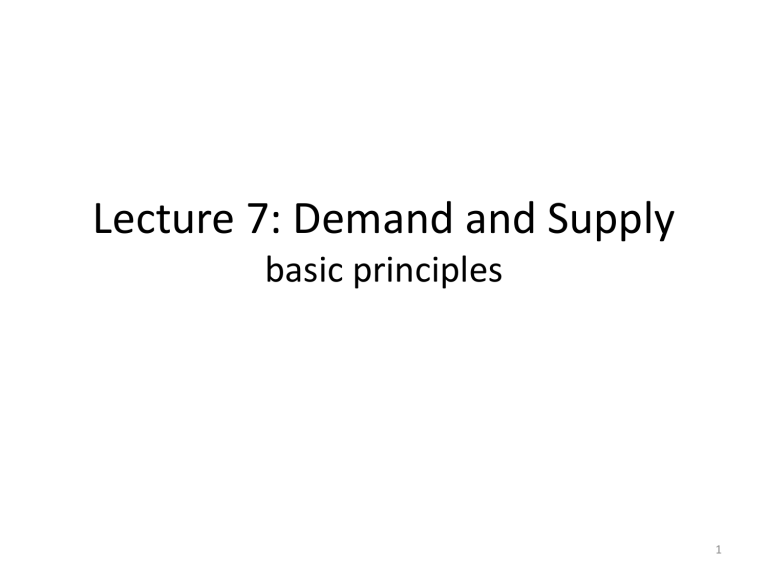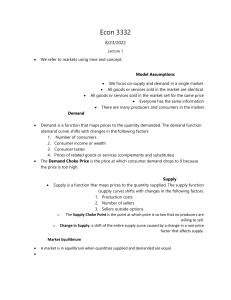
Lecture 7: Demand and Supply basic principles 1 Introduction • Market economies (and modern mixed economies) – An important role of demand and supply forces • Markets are dynamic • How is the price of a commodity determined in a market? – Demand and Supply • Demand: consumer preferences • Supply: cost of production – Policy 2 Source: Heady and Fan (2008), Anatomy of a crisis: The causes and consequences of surging food prices, IFPRI DP 00831 Merely illustration, beware of causality vis a vis correlation (more on it Unit 5) 3 The demand curve • In general, the amount of a commodity people buy depends on its price – Ceteris paribus • Demand curve: shows the relationship between market price of a good and the quantity demanded of that good – Graphical illustration – The demand curve generally slopes downward. Why? • Market demand curve: is found by adding together the quantities demanded by all individuals at a given price – Market demand: sum total of individual demands 4 The price effect • Why does the quantity demanded tend to fall with rise in prices? • Price effect = income effect + substitution effect • Substitution effect: as the price of a good rises, consumers tend to substitute it with cheaper alternatives. e.g., tea and coffee • Income effect: as the price increases, the real income of the consumers decline 5 Factors underlying the demand curve • Income of the consumers • Size of the market (population) • Prices and availability of substitute and related goods – Demand for ‘A’ is low if the price of ‘B’ is low. For example, puri-aloo and anda-bread • Tastes and preferences • Special influences – Woolens and seasonality • Example: demand for automobiles, say, car 6 Shifts in demand • The demand curve shifts whenever there is a change in the variables other than the price – Increase in average income – If average income increases, the quantity demanded at a given price too rises – Demand increases or decreases when the quantity demanded at each price increases or decreases • Shifting of a curve vs movement along a curve – Change in demand vs change in quantity demanded – Suppose a new technology reduces the costs and prices of pizzas – Increase in quantity results not from an increase in demand but from the decrease in prices • Warning on cigarette packets vis-a-vis tax 7 Take a break! • Dan Ariely: Predictably irrational • “Lemonade economics” https://www.youtube.com/watch?v=JG8PpJxp Vvo 8 The supply curve • The supply schedule relates the quantity supplied of a good to its market price, given other things • The supply curve for a commodity shows the relationship between its market price and the amount of that commodity that producers are, ceteris paribus, willing to sell • Illustration • Supply curve is upward sloping 9 Factors underlying the supply curve • Cost of production – Prices of inputs – Technology • Prices and availability of substitute and related goods – If the price of one production substitute rises, the supply of another substitute decrease – Ethanol (corn) subsidy in US and supply of soybeans • Government policy • Special influences – Weather and farming • Example: farming 10 Shifts in supply • Like the case with the demand curve, the supply curve shifts whenever there is a change in the variables other than the price – Supply increases or decreases when the amount supplied at each market price increases or decreases – Increase in wages or other costs of inputs • When the price changes, producers change their production and quantity supplied but the supply curve does not shift – And we have movement along the curve 11 Equilibrium • We now try to put both demand and supply sides together • Market equilibrium comes at a price at which quantity demanded equals quantity supplied – Illustration – The equilibrium price is also called the marketclearing price. At that price, there is no tendency for the prices to rise or fall 12 Surplus and shortage 13 Is the labour market the same? • • • • Vox on US minimum wage Washington Post The Economist Bill Gates on min wage 14 What about India? Comparative statics • Shift in supply – Bad weather and market for bread – Better technology • Shift in demand – Increase in income • Summary – Demand for “mysore pak”, diabetes, 16 Gasoline prices in the US • Gasoline demand does not obey the law of downward sloping demand. While prices rose sharply, the consumption went up – Rise in prices was due to shift in demand and not due to movements along the demand curve – Many economies grew rapidly and added to the world demand – It is helpful to look at the demand and supply together 17







